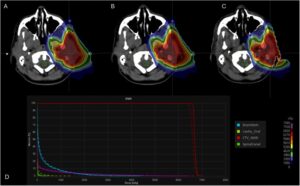GS3 – Science & Technology

Context
Recently, the Corewell Health William Beaumont University Hospital in the USA used SPArc therapy to treat a patient suffering from Adenoid Cystic Carcinoma (ACC), a rare cancer affecting the salivary glands or head and neck regions.
What is SPArc Therapy?
SPArc (Step-and-Shoot Spot-Scanning Proton Arc Therapy) is a cutting-edge proton-based radiation treatment that allows for extremely precise targeting of cancerous tumors, minimizing exposure to healthy surrounding tissues.
- It uses computer-guided proton beams to irradiate the tumor.
- Unlike conventional radiation (photon-based), SPArc reduces side effects significantly.
Advantages of SPArc:
- High Precision: Effectively delivers radiation directly to the tumor, sparing nearby organs.
- Minimal Side Effects: Patients showed only minor skin irritation, unlike traditional therapy.
- Ideal for Larger Tumors: Especially useful in managing large or complex tumor sites.
Challenges with SPArc:
- Geographic Miss Risk: Small tumors may go undetected or be poorly targeted.
- Very Expensive: High treatment costs can strain healthcare systems.
- Limited Usage: Currently applicable to only certain types of cancer.
- Positioning Sensitivity: Even slight movements, like breathing, may affect accuracy.
About Cancer:
Cancer is a condition where the body’s cells begin to divide uncontrollably and can spread to other organs.
In the South-East Asia region, India ranks 3rd in cancer incidence and 2nd in cancer-related deaths.
Cancer Treatment Methods:
- Photon-Based Therapy: Uses X-rays, but often damages healthy tissues. Side effects include xerostomia (dry mouth).
- Proton Therapy: Like SPArc and SFO-IMPT, it focuses radiation more accurately to reduce collateral damage.
- Chemotherapy: Used in advanced ACC cases but generally limited in effectiveness.
- CAR-T Cell Therapy: India’s NexCAR19 (launched in 2024) treats blood cancers such as leukemia and lymphoma.
India’s Anti-Cancer Initiatives:
- National Cancer Program (2010): Focuses on early detection and strengthening treatment facilities.
- Ayushman Bharat Yojana: Financially supports cancer patients, covering surgery, chemo, and radiotherapy.
- NexCAR19: India’s first indigenous CAR-T therapy for blood cancers.
- Cancer Genomics Repository: National database for cancer-related genetic data, aiding personalized treatment.
- National Cancer Grid (2012): Connects cancer centers across India to ensure uniform standards of care.
- Health Minister’s Cancer Patient Fund: Offers financial aid up to ₹5 lakh per patient (max ₹15 lakh).




